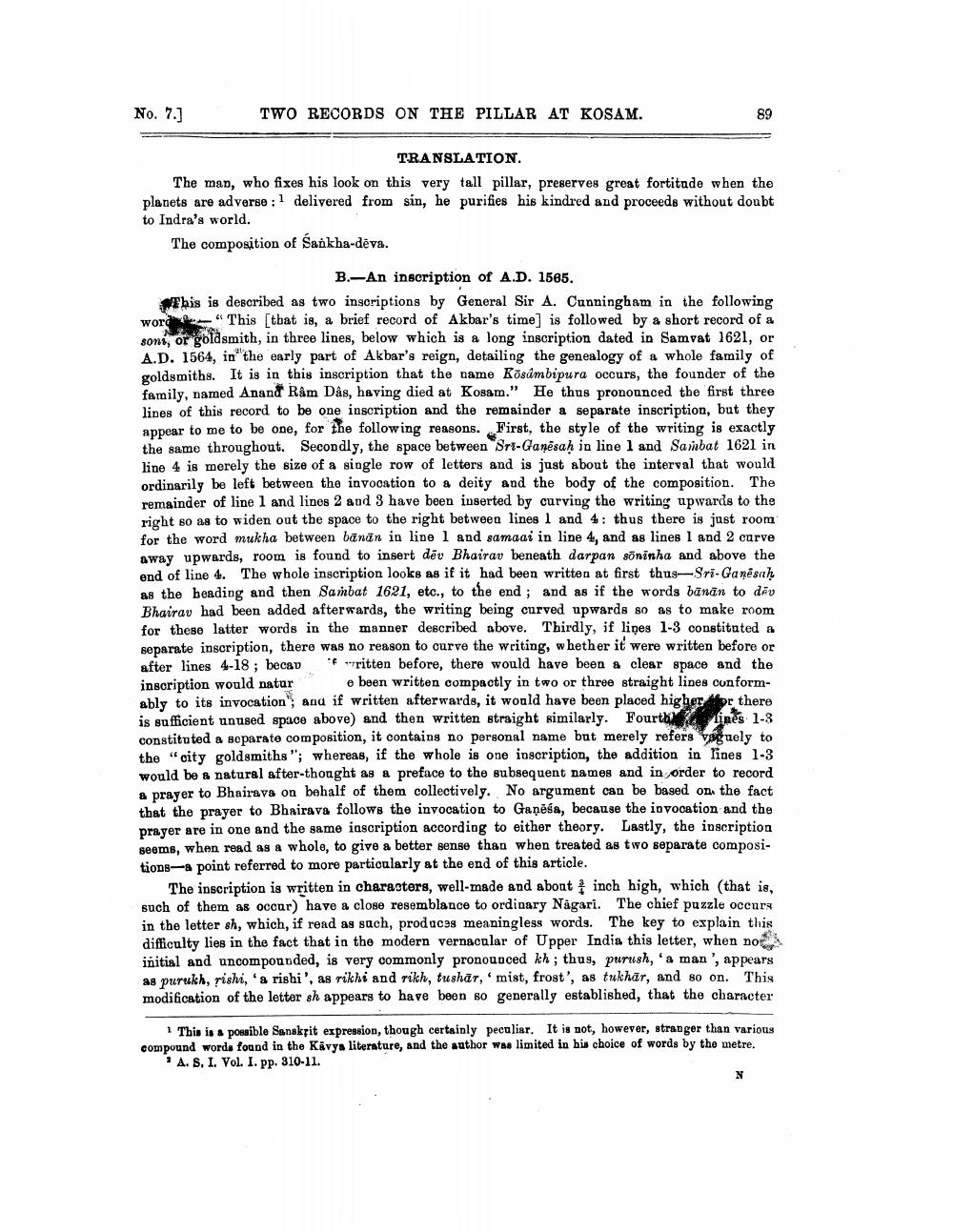________________
No. 7.]
TWO RECORDS ON THE PILLAR AT KOSAM.
TRANSLATION. The man, who fixes his look on this very tall pillar, preserves great fortitude when the planets are adverse : 1 delivered from sin, he purifies his kindred and proceeds without doubt to Indra's world.
The composition of Sankha-deva.
B.-An inscription of A.D. 1565. This is described as two inscriptions by General Sir A. Cunningham in the following word "This [that is, a brief record of Akbar's time] is followed by a short record of a sont, or goldsmith, in three lines, below which is a long inscription dated in Samvat 1621, or A.D. 1564, in"the early part of Akbar's reign, detailing the genealogy of a whole family of goldsmiths. It is in this inscription that the name Kosambipura occurs, the founder of the family, named Anand Ram Dås, having died at Kosam." He thus pronounced the first three lines of this record to be one inscription and the remainder a separate inscription, but they appear to me to be one, for the following reasons. First, the style of the writing is exactly the same throughout. Secondly, the space between Sri-Gamesah in line 1 and Sambat 1621 in line 4 is merely the size of a single row of letters and is just about the interval that would ordinarily be left between the invocation to a deity and the body of the composition. The remainder of line 1 and lines 2 and 3 have been inserted by curving the writing upwards to the right so as to widen out the space to the right between lines 1 and 4: thus there is just rooma for the word mukha between banän in line 1 and samaai in line 4, and as lines 1 and 2 carve away upwards, room is found to insert dēv Bhairav beneath darpan səninha and above the end of line 4. The whole inscription looks as if it had been written at first thus-Sri-Ganesah as the heading and then Sambat 1621, etc., to the end ; and as if the words bānān to dēv Bhairav had been added afterwards, the writing being curved upwards so as to make room for these latter words in the manner described above. Thirdly, if lines 1-3 constituted a separate inscription, there was no reason to curve the writing, whether it were written before or after lines 4-18; becav F written before, there would have been a clear space and the inscription would natur e been written compactly in two or three straight lines conformably to its invocation, and if written afterwards, it would have been placed higher or there is sufficient unused space above) and then written straight similarly. Fourth lines 1-3 constituted a separate composition, it contains no personal name but merely refers vaguely to the "city goldsmiths"; whereas, if the whole is one inscription, the addition in lines 1-3 would be & natural after-thought as a preface to the subsequent names and in order to record & prayer to Bhairava on behalf of them collectively. No argument can be based on the fact that the prayer to Bhairava follows the invocation to Gaņēśa, because the invocation and the prayer are in one and the same inscription according to either theory. Lastly, the inscription seems, when read as a whole, to give a better sense than when treated as two separate compositions-a point referred to more particularly at the end of this article.
The inscription is written in characters, well-made and about inch high, which (that is, such of them as occur) have a close resemblance to ordinary Nagari. The chief puzzle occurs in the letter sh, which, if read as such, produces meaningless words. The key to explain this difficulty lies in the fact that in the modern vernacular of Upper India this letter, when no initial and uncompounded, is very commonly pronounced kh ; thus, purush, 'a man', appears as purukh, rishi, a rishi', as rikhi and rikh, tushār, 'mist, frost', as tukhār, and so on. This modification of the letter sh appears to have been so generally established, that the character
1 This is a possible Sanskrit expression, though certainly peculiar. It is not, however, stranger than various compound words found in the Kavya literature, and the author was limited in his choice of words by the metre. ? A. S. I. Vol. I. pp. 310-11.
N




